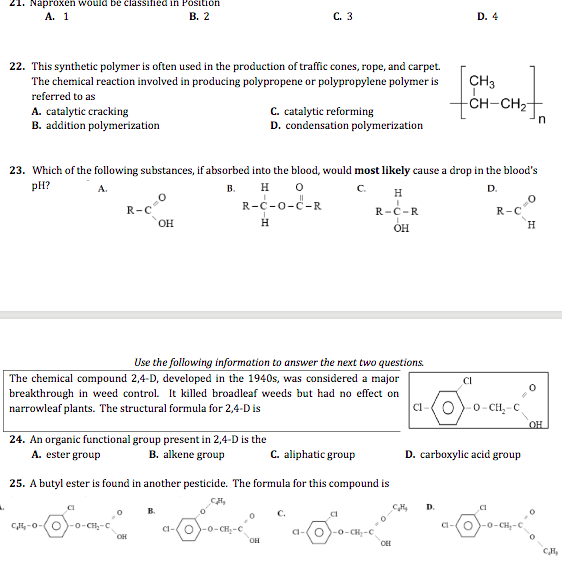A. 1 В. 2 С. 3 D. 4 22. This synthetic polymer is often used in the production of traffic cones, rope, and carpet. The chemical reaction involved in producing polypropene or polypropylene polymer is CH3 -CH-CH2- referred to as A. catalytic cracking B. addition polymerization C. catalytic reforming D. condensation polymerization 23. Which of the following substances, if absorbed into the blood, would most likely cause a drop in the blood's B. H O R-C-0-C-R pH? A. C. D. H R-C R-C-R R-C OH H.
A. 1 В. 2 С. 3 D. 4 22. This synthetic polymer is often used in the production of traffic cones, rope, and carpet. The chemical reaction involved in producing polypropene or polypropylene polymer is CH3 -CH-CH2- referred to as A. catalytic cracking B. addition polymerization C. catalytic reforming D. condensation polymerization 23. Which of the following substances, if absorbed into the blood, would most likely cause a drop in the blood's B. H O R-C-0-C-R pH? A. C. D. H R-C R-C-R R-C OH H.
Chemistry: The Molecular Science
5th Edition
ISBN:9781285199047
Author:John W. Moore, Conrad L. Stanitski
Publisher:John W. Moore, Conrad L. Stanitski
Chapter10: Fuels, Organic Chemicals, And Polymers
Section10.6: Synthetic Organic Polymers
Problem 10.7PSP
Related questions
Question
Answer 21,22,23

Transcribed Image Text:21. Naproxen would be classified in Position
А. 1
В. 2
С. 3
D. 4
22. This synthetic polymer is often used in the production of traffic cones, rope, and carpet.
The chemical reaction involved in producing polypropene or polypropylene polymer is
CH3
-CH-CH2-
referred to as
A. catalytic cracking
B. addition polymerization
C. catalytic reforming
D. condensation polymerization
23. Which of the following substances, if absorbed into the blood, would most likely cause a drop in the blood's
pH?
A.
В.
но
C.
D.
н
R-C
R-C-0-с-R
R-C-R
R-C
OH
H.
Use the following information to answer the next two questions.
The chemical compound 2,4-D, developed in the 1940s, was considered a major
breakthrough in weed control. It killed broadleaf weeds but had no effect on
narrowleaf plants. The structural formula for 2,4-D is
CI
Cl
0- CH,-C
OH
24. An organic functional group present in 2,4-D is the
A. ester group
B. alkene group
C. aliphatic group
D. carboxylic acid group
25. A butyl ester is found in another pesticide. The formula for this compound is
D.
CI
C-0
O)-0-CH,-C
O)-0-CH,-C,
Cl-
C1-( O
-0-CH;-C
O)-0-CH;-C
a-
OH
CH.
Expert Solution
This question has been solved!
Explore an expertly crafted, step-by-step solution for a thorough understanding of key concepts.
Step by step
Solved in 4 steps with 2 images

Knowledge Booster
Learn more about
Need a deep-dive on the concept behind this application? Look no further. Learn more about this topic, chemistry and related others by exploring similar questions and additional content below.Recommended textbooks for you

Chemistry: The Molecular Science
Chemistry
ISBN:
9781285199047
Author:
John W. Moore, Conrad L. Stanitski
Publisher:
Cengage Learning

Physical Chemistry
Chemistry
ISBN:
9781133958437
Author:
Ball, David W. (david Warren), BAER, Tomas
Publisher:
Wadsworth Cengage Learning,

Chemistry for Engineering Students
Chemistry
ISBN:
9781337398909
Author:
Lawrence S. Brown, Tom Holme
Publisher:
Cengage Learning

Chemistry: The Molecular Science
Chemistry
ISBN:
9781285199047
Author:
John W. Moore, Conrad L. Stanitski
Publisher:
Cengage Learning

Physical Chemistry
Chemistry
ISBN:
9781133958437
Author:
Ball, David W. (david Warren), BAER, Tomas
Publisher:
Wadsworth Cengage Learning,

Chemistry for Engineering Students
Chemistry
ISBN:
9781337398909
Author:
Lawrence S. Brown, Tom Holme
Publisher:
Cengage Learning